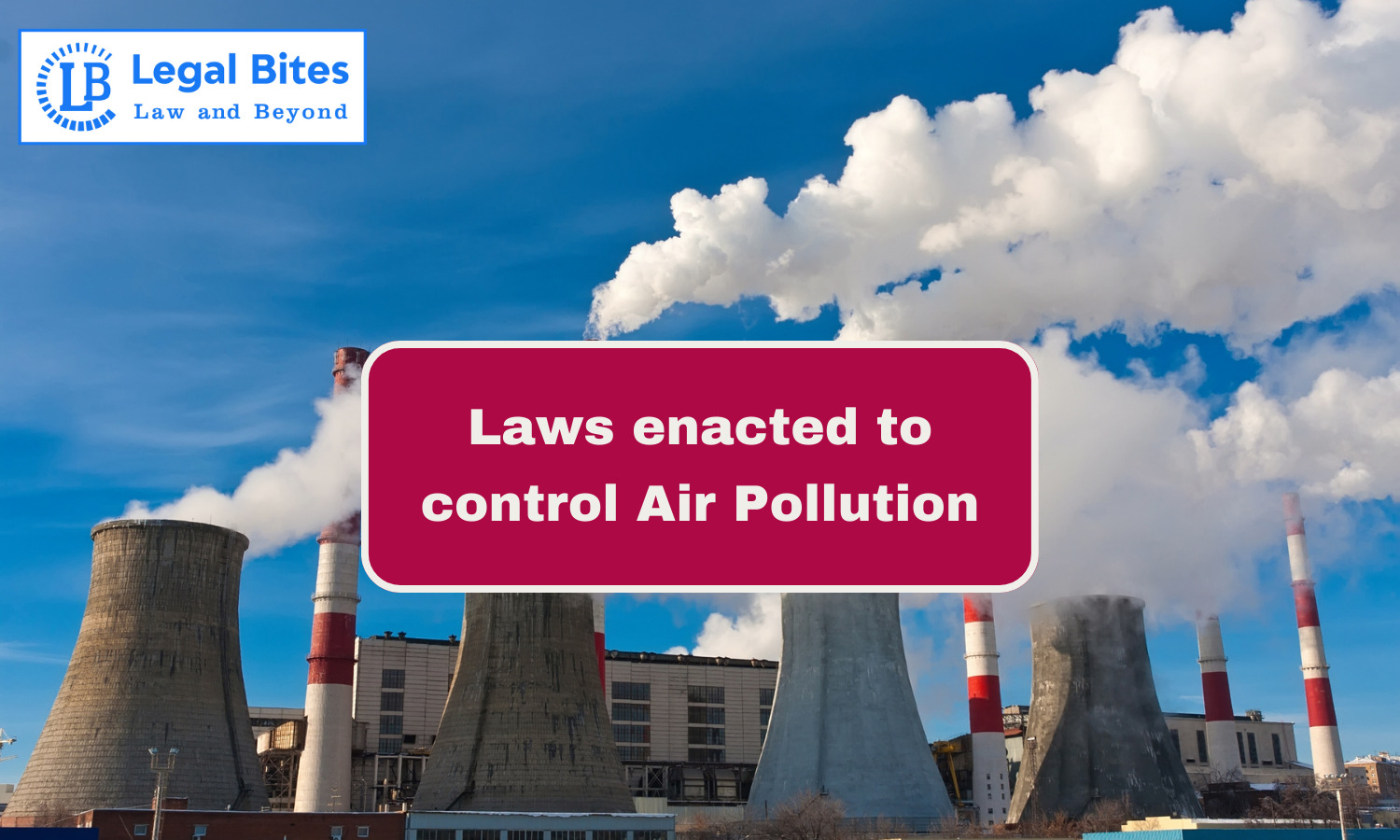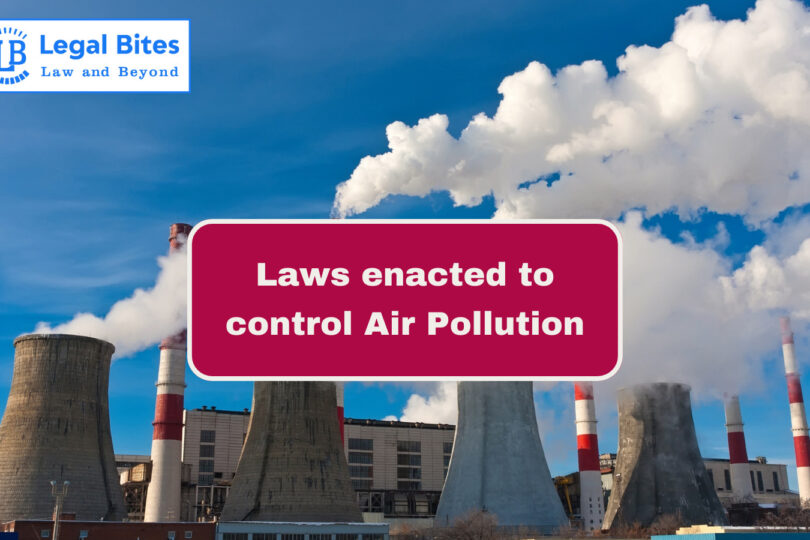
The article ‘Laws enacted to control Air Pollution’ attempts to explain the legislation in place for preventing and controlling air pollution and whether they are adequate or not. The article also analyses what is the way forward in this regard.
In the Indian context, it is clear that population development is trending upward and that this has an impact on air quality. For instance, the total population of the megacities of Delhi, Mumbai, and Kolkata is more than 46 million. Effective steps to reduce air pollution are required due to India’s urban cities’ ongoing decline in good air quality. The Government of India has instituted several policy measures to reduce industrial and vehicular emissions, but it is unclear how well these measures are being carried out.
Introduction
Several nations throughout the world now have laws in place to protect clean air. A state cannot prioritise economic growth at the expense of the environment. According to the Environment Performance Index, India has the poorest environmental conditions out of 132 nations. The poor quality of India’s air is caused by several issues. In today’s most industrialised nations, like China, maintaining clean air has proven difficult. Article 48A of the Directive Principles of our Indian Constitution states that the state works to conserve the country’s forests and wildlife, as well as to protect the environment. Article 51A imposes a similar fundamental duty on citizens. Thus, having effective laws and mechanisms is essential.
Environmental Protection has grown to be a major concern as a result of development and industrialization. Due to its rapid development and improper use of environmental pollution management regulations, India, a rising power, has been dealing with environmental pollution. The right to life is covered under Article 21 of our Indian Constitution, which has a direct relationship to the environment. Therefore it does become the State’s responsibility in helping to maintain clean air for a healthy life of all the citizens of the country.
Laws that Prevent and Control Air Pollution
The Air (Prevention and Control of Pollution) Act of 1981 (Air Act) and the Environment (Protection) Act of 1986 is the two primary laws that govern air pollution in India (EPA). Let us now briefly discuss both of these legislations to comprehend how they assist in preventing as well as controlling air pollution in India.
1. Environment Protection Act, 1986
In 1986, the Environment Protection Act was passed. The Department of Environment was founded in India in 1980 before this statute. It changed its name to the Ministry of Environment and Forests in 1985. In a similar vein, this statute was preceded in 1981 by The Air (Prevention and Control of Pollution) Act. This law’s goal is to take the necessary action to protect and develop the environment while preventing risks to people, other living things, plants, and property. The term “environment contamination” has been comprehensively defined under this act.
Some of how this Act deals with air pollution have been mentioned as follows:
- The general authority of the Central government is covered in Chapter 2. The Central Government shall have the authority to take any actions it deems appropriate to protect and enhance the quality of the environment.
- The Central Government is also required by this Act to prevent and control environmental pollution, safeguard against accidents that may result in environmental pollution, and provide post-accident medical care, among other things.
- The third chapter discusses environmental control methods for prevention, management, and mitigation. Any person who engages in any industry activity or process is prohibited from discharging, emitting, or authorising the discharging or emission of any environmental pollution over any authorised standards.
- In case a company violates any of the provisions of this Act, both the company and every officer, such as a director, manager, secretary, or other officers, who at the time the violation occurred had direct control over and responsibility for the company’s conduct of business will be deemed guilty of the violation and subject to legal action and punishment as appropriate.
2. Air (Prevention and Control of Pollution) Act, 1981
This Act, as its name suggests, has been drafted with the objective of safeguarding the air to provide clean air to all the present generations and promise equally clean air for future generations.
Let us comprehend some of the highlighting features of this Act by which it aims to control air pollution:
- The powers and duties of boards are covered in Chapter 3 of this Act. The Central Board and State Boards are the two boards. They perform crucial duties such as advising the government on issues about air quality improvement, air pollution prevention, control, and abatement, as well as improving air quality and preventing, controlling, and abating air pollution in the nation.
- To establish air quality standards, examine any control devices, industrial facilities, or manufacturing processes at all reasonable times, and issue orders to the people it deems essential to take action to avoid, regulate, or lessen air pollution.
- Conduct periodic inspections of places where air pollution is controlled, evaluate the air there, and take action to avoid, regulate, or lessen air pollution there.
- The State Government may designate any area or areas within the State as air pollution control areas for this Act after consulting with the State Board. The State Government may also change any air pollution control area, whether by extension or reduction, or by designating a new air pollution control area into which one or more existing air pollution control areas, or any portion(s) thereof, may be merged.
Landmark Case Laws
1. MC Mehta (Taj Trapezium Matter) v. Union of India, (1987 AIR 1086)
There were numerous industries close to the Taj Mahal. Industrial/refinery emissions, brick kilns, automobile traffic, and generators are the main causes of ambient air pollution near the Taj Mahal. According to the petition, marble’s once-whitish hue has changed to one that is yellowish and blackish.
The Guidelines established in this case are:
Sustainable Development: The growth of the industry is crucial for the economy, but it is also important to maintain the environment. Thus, stopping pollution is the goal of this legal action.
The Precautionary Principle: It states that since pollution is a by-product of progress, the state must foresee, prevent, and mitigate environmental damage.
Polluter Pays Principle: The court interpreted the “polluter pays” principle to mean that the absolute liability to harm the environment includes not only compensating the victims of pollution but also covering the costs associated with reversing environmental degradation.
2. Union Carbide Corporation v. Union of India, (AIR 1988 SC 1531)
The greatest industrial accident in history took place on December 3, 1984. About 40 tonnes of methyl isocyanate (MIC) gas from a chemical plant owned and run by Union Carbide (India) Ltd was combined with other dangerous pollutants. In this catastrophe, at least 3,800 people died and several others were hurt.
The Supreme Court utilised the idea of absolute liability to order the Union Carbide Corporation to make restitution. In comparison to the crime that has a lasting impact on the local population, it is quite minor. Even after this catastrophe, India’s industrialisation has advanced quickly. Rapid and poorly regulated industrial growth continues to pose serious environmental dangers, notwithstanding some positive changes in government policy and practises in a few industries. India continues to experience negative implications for human health as a result of widespread environmental degradation.
Are the legislations effective? If not, what is the way forward?
It is imperative to note that while there are legislations in India that pertain to discussing the control and prevention of air pollution, which is of ardent need in today’s time, the implementation or, rather the effectiveness of the same can not be witnessed in today’s date. It is crucial that while there is the presence of such legislation, there is also a mechanism that monitors effective implementation. Apart from implementation, another issue that becomes a hurdle in providing clean air to the citizens, is the problem of lack of awareness which again partly becomes the responsibility of the State, which it can fulfil by creating adequate mechanisms and legal initiatives which enhance the weightage of the fact that it is highly important to cater to this facet of the environment.
For instance, every year, due to stubble burning, there is a tremendous amount of smog created in Delhi and other neighbouring states. However, there is still no concrete action taken by governments both at the centre as well as the state level. It is equally important for states at both levels to take the matter into their own hands to make sure that there are sufficient ways in which air pollution is thereby targeted.
Another way is to pay more emphasis on the air quality standards, which are deteriorating every year around the same time during which stubble burning occurs. Apart from that, there must be stricter regimes for traffic control as that too contributes to air pollution.
It becomes crucial to analyse the root causes which are certainly not being addressed. It would be beneficial if not merely the administration but also the population at large took up this responsibility and behavedit is adequate ethically in a manner that contributes to collectively reducing air pollution.
Conclusion
The article thus assisted us in understanding India’s current position in legally attempting to combat the alarming situation of air pollution and the legal mechanism that has been put in place to deal with the said crisis. As discussed above, more than the presence of laws and other mechanisms, it is important for all the actors and the stakeholders involved in this situation to take ownership and treat this urgency as their own. It is imperative to realise the necessity of this issue and thereby assist in reducing pollution in any way possible whether it relates to reducing the bursting of crackers on some specific religious or other occasions, car-pooling to reduce traffic, or switching over to other alternatives.
References
[1] Ankita Kankaria, Indoor Air Pollution in India: Implications on Health and its Control, Available Here
[2] Environment Protection under Constitutional Framework of India, Available Here
[3] Dr Bhola Ram Gurjar, Air Pollution in India: Major Issues and Challenges, Available Here
[4] Sharon Mathew, Marking 40 Years of India’s Air Act, Available Here
Important Links
Law Library: Notes and Study Material for LLB, LLM, Judiciary, and Entrance Exams
